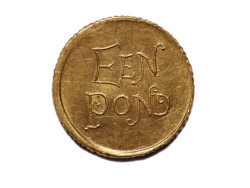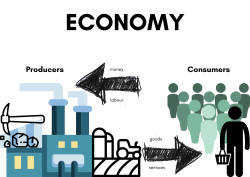NMAH and London School of Economics's collections
Money and Exchange in West Africa
<p>The objects in this collection, from the crescent-shaped manilla to the colorful banknotes, formed part of West Africa’s vibrant and varied monetary system in the nineteenth and twentieth centuries. Each object has its own story about when and how it was used. A person shopping in a market in Accra, Ghana in the 1980s, for example, might have received the 1 cedi coin below as change from a small transaction. In the Akan language, the word “cedi” means cowrie shell, a currency which a person shopping in the same market a century earlier might have used. Like the 1 cedi coin, cowrie shells were used to make small purchases. Symbolically, the image of a cowrie shell appears on the coin. Not far from Accra, in the old Asante city of Kumasi, the figurative gold weights pictured here would have been used around the same time to measure gold dust for transactions ranging from significant market purchases to judicial fines. </p>
<p>How did West Africa move from a monetary system based on objects like manillas, gold dust, and cowrie shells to one based on notes and coins? It was once popular to attribute this change to the colonization of West Africa by European governments in the nineteenth century. According to this story, colonial governments wanted to impose their own “modern” currencies on West African economies to make it easier for merchants and colonial authorities to do business between the colony and Europe. From recent historical research on West African currencies and their uses, we now know the story is not that simple. Colonial governments did introduce new currency systems with European forms of money, but they were not immediately or universally adopted by Africans in the way that colonial governments intended. </p>
<p>After the end of the colonial period, some countries like Ghana and Nigeria, issued their own currencies as an expression of national sovereignty. Other new countries, such as Senegal and the Ivory Coast, focused instead on building or maintaining monetary unions with shared currencies in order to reinforce links between their economies. Some of these post-colonial coins and banknotes depict pre-colonial currencies, like the cowrie on the Ghanaian cedi coin or the Kissi penny on the Liberian dollar. </p>
<p>The history of West African money from the nineteenth century onwards reflects the history of economic, political, and social change in the region over that same period. This collection uses objects from the Smithsonian’s National Numismatic Collection to tell that history, linking to broader questions about the nature and uses of money, the ways in which economic change can influence how money is used, and the relationship between money and political sovereignty.</p>
<p> </p>
<p>Below is a list of suggested readings on West African money and exchange. To see all of the West African currency objects in the National Numismatic Collection, click <a href="https://americanhistory.si.edu/collections/search?edan_q=west%20african%20currency&edan_local=1&edan_fq%5B%5D=topic:%22West+African+Currency%22">here</a>.
</p>
<p>This project was generously funded by the <a href="https://info.lse.ac.uk/staff/services/knowledge-exchange-and-impact">Knowledge Exchange and Impact Fund</a> at the London School of Economics. Please feel free to reach out to <a href="https://www.lse.ac.uk/Economic-History/People/Faculty-and-teachers/Dr-Leigh-Gardner">Dr. Leigh Gardner</a> or <a href="mailto:feingolde@si.edu">Dr. Ellen Feingold</a> with questions or feedback.<br>
</p>
<p><strong><u>Suggested Reading</u></strong></p>
<p><strong></strong></p>
<p><strong>Historical overviews:</strong></p>
<p>Gardner, Leigh A. “From Cowries to Mobile Phones: African Monetary Systems Since 1800.” In <em>The History of African Development: An Online Textbook for a New Generation of African Students and Teachers</em>, edited by Ewout Frankema, Ellen Hillbom, Ushehwedu Kufakurinani, and Felix Meier zu Selhausen. African Economic History Network (2018): <a href="https://nam02.safelinks.protection.outlook.com/?url=https%3A%2F%2Fwww.aehnetwork.org%2Ftextbook%2Ffrom-cowries-to-mobile-phones-african-monetary-systems-since-1800%2F&data=02%7C01%7CFeingoldE%40si.edu%7C98acf6fffa7541e2bfe408d73b853535%7C989b5e2a14e44efe93b78cdd5fc5d11c%7C0%7C1%7C637043315626494647&sdata=aLCbF3KF47k6hDHgf%2BVlYmr3umQwJlhQg3EJnbahxOM%3D&reserved=0">https://www.aehnetwork.org/textbook/from-cowries-to-mobile-phones-african-monetary-systems-since-1800/</a></p>
<p>Guyer, J. and Karin Pallaver. "Money and Currency in African History.” <em>Oxford Research Encyclopedia of African History</em> (2018): <a href="https://oxfordre.com/africanhistory/view/10.1093/acrefore/9780190277734.001.0001/acrefore-9780190277734-e-144">https://oxfordre.com/africanhistory/view/10.1093/acrefore/9780190277734.001.0001/acrefore-9780190277734-e-144</a></p>
<p><br></p>
<p><strong>Pre-colonial currencies:</strong>
</p>
<p>Arhin, Kwame. “Monetization in the Asante State.” In <em>Money Matters: Instability, Values and Social Payments in the Modern History of West African Communities</em>, edited by Jane I. Guyer, 97-110. London: James Currey, 1995.</p>
<p>Herbert, Eugenia W. <em>Red Gold of Africa: Copper in Precolonial History and Culture. </em>Madison: University of Wisconsin Press, 1984.</p>
<p>Hogendorn, Jan S., and Marion Johnson. <em>The Shell Money of the Slave Trade</em>. Cambridge: Cambridge University Press, 2003.</p>
<p><br></p>
<p><strong>Colonial currency systems and African responses:</strong>
</p>
<p>Feingold, Ellen R. "International Currency Counterfeiting Schemes in Interwar West Africa." <em>Journal of West African History</em> 3, no. 1 (2017): 77-101. </p>
<p>Gardner, Leigh A. “The Curious Incident of the Franc in the Gambia.” <em>Financial History Review</em> 22, no. 3 (2015): 291-314.</p>
<p>Gardner, Leigh A. "The Rise and Decline of Sterling in Liberia.” <em>Economic History Review </em>64, no. 4 (2014): 1089-1112.</p>
<p>Guyer, Jane I. “Introduction: The Currency Interface and its Dynamics.” In <em>Money Matters: Instability, Values and Social Payments in the Modern History of West African Communities</em>, edited by Jane I. Guyer, 1-34. (London: James Currey, 1995).</p>
<p>Helleiner, Eric. “The Monetary Dimensions of Colonialism: Why Did Imperial Powers Create Currency Blocs?” <em>Geopolitics</em> 7, no. 1 (2002): 5-30.</p>
<p>Hogendorn, Jan S., and Henry A. Gemery. “Continuity in West African Monetary History? An Outline of Monetary Development.” <em>African Economic History</em> 17 (1988): 127-146. </p>
<p>Hopkins, A.G. “The Currency Revolution in South-West Nigeria in the Late Nineteenth Century.” <em>Journal of the Historical Society of Nigeria</em> 3, no. 3 (1966): 471-483. </p>
<p>Saul, Mahir. “Money in Colonial Transition: Cowries and Francs in West Africa.” <em>American Anthropologist </em>106, no. 1 (2004): 71-84.</p>
<p><br></p>
<p><strong>Money and national independence:</strong></p>
<p>Schenk, Catherine R. “Monetary Institutions in Newly Independent Countries: The Experience of Malaya, Ghana, and Nigeria in the 1950s.” <em>Financial History Review</em> 4, no. 2 (1997): 181-198.</p>
<p>Stasavage, David. <em>The Political Economy of a Common Currency: the CFA Franc Zone Since 1945</em>. Aldershot: Ashgate (2003).</p>
<p>Uche, Chibuike U. “Bank of England vs. the IBRD: Did the Nigerian Colony Deserve a Central Bank?” <em>Explorations in Economic History</em> 34 (1997): 220-241.
</p>
 NMAH and London School of Economics
NMAH and London School of Economics
31
U.S. Dollars in Liberia
<p><strong><em><a href="https://americanhistory.si.edu/national-numismatic-collection/galleries-and-exhibitions">The Value of Money</a></em> exhibition's new acquisition case is currently featuring a display on the use of <a href="https://americanhistory.si.edu/blog/dollars-liberia">U.S. Dollars in Liberia</a>. This Learning Lab makes this display available digitally. </strong></p>
<p><strong><u>U.S. Dollars in Liberia </u></strong></p>
<p>From 1820 to 1904, about 16,000 people formerly enslaved in the United States sailed to West Africa and established the country now known as Liberia. The American Colonization Society, which sought to create a colony in Africa for formerly enslaved people, issued currency like this 1833 token and established a government led by white officials. <br></p>
<p>In 1847 Liberian migrants declared independence from the American Colonization Society and issued their own coins as a symbol of nationhood. The coins were minted in England and circulated alongside indigenous currencies like the Kissi penny. In the late 19th and early 20th century, the Liberian government struggled with debt, making it difficult for the Liberian dollar to maintain its value. As a result, merchants and then the government began to use the colonial currency of British West Africa instead. </p>
<p>In 1943, with financial help from the U.S. government, the U.S. dollar replaced British West African shillings as the primary currency in circulation. The Liberian dollar continued to be in use as small change. Today Liberia is one of few nations with a dual currency system, as both American and Liberian dollars circulate alongside each other. In 2019 the National Numismatic Collection acquired contemporary Liberian banknotes to help tell this story. </p>
<p><strong><u>Suggested Reading:</u></strong></p>
<p>Gardner, Leigh A. "The rise and fall of sterling in Liberia, 1847-1943." <em>Economic History Review</em> 67, no. 4 (2014): pp. 1089-1112. </p>
<p>Rosenberg, Emily S. <em>Financial Missionaries to the World: The Politics and Culture of Dollar Diplomacy 1900-1830</em>. Chapel Hill: Duke University Press, 2007. </p>
<p><br></p>
<p>To see all of the West African currency objects in the National Numismatic Collection, click <a href="https://americanhistory.si.edu/collections/search?edan_q=west%20african%20currency&edan_local=1&edan_fq%5B%5D=topic:%22West+African+Currency%22">here</a>. <br><br><br><br></p>
 NMAH and London School of Economics
NMAH and London School of Economics
7
What did money look like under colonial rule in West Africa?
<p>How did colonialism affect the lives and livelihoods of Africans? The kinds of money people used can provide some clues. This collection contains coins and notes introduced by the colonial powers which Africans received in return for the sale of produce and used for paying taxes. It also includes cowrie shells, kissi pennies and manillas, which Africans often used to buy everyday goods in local markets despite colonial government policies banning them. </p>
 NMAH and London School of Economics
NMAH and London School of Economics
12
South African lesson 1: A quick history of money: What can money tell us about the world?
<p>In this resource, we will explore the questions: What is money? And what does it tell us about the world?</p>
<p>By looking at the history of money around the world, we will discover the different shapes and forms money can take, and think about how the history of money can help us understand the past and the present. This exercise ends with an exciting activity that gives students the opportunity to apply what they have learned by creating their own money.</p>
<p>*This lesson was developed by a South African History graduate (Amy Rommelspacher, amyrom@sun.ac.za), as part of a collaboration between Stellenbosch University, the London School of Economics and the Smithsonian with a goal of creating lesson plans for South African students using objects from the National Numismatic Collection. There are four lessons in total.</p>
<p>Find the next lessons here:</p>
<p><a href="https://learninglab.si.edu/collections/south-african-lesson-2-minerals-and-money/3zt8IfdTrVQCvnUA">South African lesson 2: Minerals and money</a><br></p>
<p><a href="https://learninglab.si.edu/collections/south-african-lesson-3-the-great-depression-the-gold-standard-and-south-africa/HPZ2cJN1jRXri3mg">South African lesson 3: The Great Depression, the gold standard and South Africa</a></p>
<p><a href="https://learninglab.si.edu/collections/south-african-lesson-4-bretton-woods-national-currencies-and-south-africa-s-new-money/DvAXfJ1hzRn5YxpU">South African lesson 4: Bretton Woods, national currencies and South Africa's new money</a></p>
<p><br></p>
<p><a href="https://learninglab.si.edu/collections/south-african-lesson-2-minerals-and-money/3zt8IfdTrVQCvnUA"><br></a></p>
<p><br><br></p>
 NMAH and London School of Economics
NMAH and London School of Economics
11
South African lesson 2: Minerals and Money
<p>This lesson explores how currencies are used in different economies, with a focus on South Africa and how the Mineral Revolution in South Africa affected its economies and currencies.</p>
<p>*This lesson was developed and created by a South African History graduate (Amy Rommelspacher, amyrom@sun.ac.za), as part of a collaboration between Stellenbosch University, the London School of Economics and the Smithsonian with a goal of creating lesson plans for South African students using objects from the National Numismatic Collection. There are four lessons in total.</p>
<p>Find the next lessons here:</p>
<p><a href="https://learninglab.si.edu/collections/south-african-lesson-3-the-great-depression-the-gold-standard-and-south-africa/HPZ2cJN1jRXri3mg">South African lesson 3: The Great Depression, the gold standard and South Africa</a></p>
<p><a href="https://learninglab.si.edu/collections/south-african-lesson-4-bretton-woods-national-currencies-and-south-africa-s-new-money/DvAXfJ1hzRn5YxpU">South African lesson 4: Bretton Woods, national currencies and South Africa's new money</a></p>
 NMAH and London School of Economics
NMAH and London School of Economics
13
South African lesson 3: The Great Depression, the gold standard and South Africa
<p>This lesson looks at the Great Depression and the gold standard in South Africa and how these impacted the way that money worked in the country, and many other countries in the world.</p>
<p>*This lesson was developed by a South African History graduate (Amy Rommelspacher, amyrom@sun.ac.za), as part of a collaboration between Stellenbosch University, the London School of Economics and the Smithsonian with a goal of creating lesson plans for South African students using objects from the National Numismatic Collection. There are four lessons in total.</p>
<p>Find the next lesson here:</p>
<p><a href="https://learninglab.si.edu/collections/south-african-lesson-4-bretton-woods-national-currencies-and-south-africa-s-new-money/DvAXfJ1hzRn5YxpU">South African lesson 4: Bretton Woods, national currencies and South Africa's new money</a><br></p>
 NMAH and London School of Economics
NMAH and London School of Economics
14




